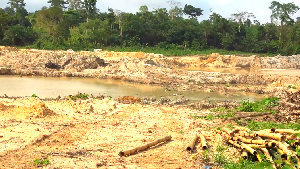Every Ghanaian citizen should be happy and support the actions being taken by the state against illegal mining/miners in recent months especially due to the environmental menace these illegal miners have brought upon the country.
The cost of reclaiming forest from degradation, massive pollution of water bodies, and the loss of livelihoods to many rural dwellers whose lands and farms have been destroyed through irresponsible activities of these illegal miners places a heavy responsibility on the state, supported by all citizens to clean up the mining sector and clear the mess therein.
It is, however, important that whatever the state does, or chooses to be done in protecting the nation from these vampires be done according to the rules stipulated in the law.
In the operations being carried out by the military under Operation Halt!, it has come to light that the operatives have been burning excavators and all the equipment seized from the illegal miners.
On the surface, yes, the miners called for it and deserve the loss of their equipment. But the question one may ask is whether the burning of these equipment is grounded in law and it is the most sensible course of action available to us?
During the anti-illegal mining operations by the inter-ministerial task force between 2013 and 2015, this same issue of dealing with the equipment of illegal miners became topical as the security services accused the courts of releasing the equipment back to their owners after arrests had been made.
However, the then Minister for Lands and Natural Resources Nii Osah Mills presented an amendment of the Minerals and Mining Law 2006 (Act 703) to parliament and the amendment was effected in December 2015.
And parts of the amendment provided a clear direction as to how to go about dealing with equipment and products of illegal mining.
Subsections (2), (3), (4) of section 99 of the law as amended forbid (i) mining without license, (ii) foreigners participating in small-scale mining (iii) employing foreigners in licensed small-scale mining activities.
“Where a person is arrested for an offence under subsections (3) and (4), any equipment used in, or associated with the commission of the offence, and any product derived from the commission of the offence shall regardless of the ownership of the equipment or products be seized and kept in the custody of the police.”
It is also important to note that subsections (2), (3) and (4) provide for summary conviction of persons who are found to have broken the law.
That is the provision in subsection (5) of section 99 of the Minerals and Mining Act 2006 (Act 703) as amended in December 2015. But subsection (6) states that “A court which convicts a person for an offence under subsections (2), (3) and (4) of 99 SHALL (caps mine) in addition to the penalty that it may impose, ORDER(caps mine) forfeiture of any equipment and product seized under subsection (5) to the state.
Not being a lawyer, one stands the risk of misinterpreting the law, although the language is quite straightforward in this matter.
By the provisions above, it seems obvious that equipment and products seized from illegal miners under subsections (2), (3), and (4), were to be treated initially as exhibits and kept in police custody until the determination of the case by a court of competent jurisdiction, which the law stated in subsection (8) also includes circuit courts.
It, therefore, becomes problematic, if what is quoted above is what the law says, to see military men, burning equipment of alleged illegal miners on site. That amounts to instant justice.
Moreover, to the layman, the provision in subsection (7) gives an order to the Minister for lands and natural resources as to what to do with equipment and products of illegal mining, once the suspects are convicted and the court orders the forfeiture of the products and equipment seized, which until the final determination of the case, should have been in police custody.
“The minister shall, within sixty days after the confiscation of equipment or products, allocate the equipment or product to the appropriate state institution, and order a publication in the gazette the name of the state institution to which the equipment or product has been allocated.”
In all of the above, the interest of the state has been protected, once there is incontrovertible evidence of an offence or offences against subsections (2), (3), and (4) of section 99 of the mineral and mining Act, 2006 (Act 703) as amended (December 2015).
This makes the burning of equipments which are potential state assets by the military, a matter of grave concern. Meanwhile, the 260 MMDAs in the country have dire need of some of those equipment for their activities, and indeed, some hire such equipments for dredging of watercourses from time to time, road repairs, construction activities and other responsibilities that they undertake. It, therefore, looks like a wanton waste of resources, and perhaps by extension causing financial loss to the country, when our men in uniform, in flagrant disregard of the law, burn such equipment summarily.
It also becomes problematic, when the Minister and President under whom these actions are taken are men of the legal profession, and should have known better than laymen, how to apply the law.
The Mines and Energy Committee of parliament needs to summon the Minister for Lands and Natural Resources to answer questions on the activities of the members of the Operation Halt team, whether their actions are in line with the law.
Opinions of Thursday, 27 May 2021
Columnist: Justice Lee Adoboe















